Whole set of 24 Seymour Mead & Co. LTD (TEA) Trade cards, on Ceylon, her tea and other industries “THE ISLAND OF CEYLON”, Issued in 1955. (series A)
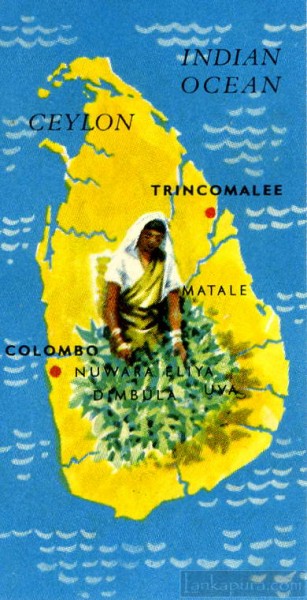
Ceylon lies immediately south of India, separated from it by the narrow Palk Strait. It is shaped like a pear or Pearl-drop and is sometimes referred to as “The Pearl of the East”. Ceylon is 271 miles long and 140 miles broad-about half the size of England. Its ancient name was Lanka, when it was ruled by Sinhalese kings. Today (1955) ceylon is a member of the British Commonwealth. The population of 9 million comprises a diversity of races, with the Sinhalese as the major community, but all people who come from Ceylon are known as Ceylonese. The chief products are tea, rubber, coconuts and rice. On this map the main tea regions are shown. Text on Back of the card
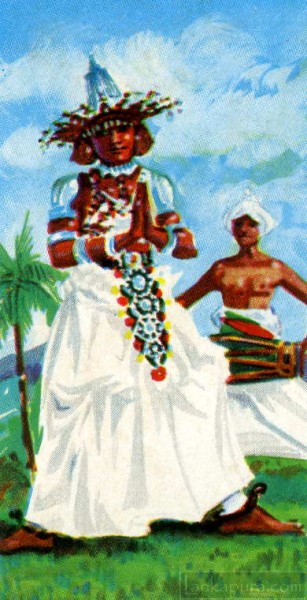
The city of Kandy, last capital and stronghold of the Sinhalese Kings, lies roughly in the centre of Ceylon, and in the heart of the great upland tea-growing areas. It is famous for the octagonal-shaped Temple of the Tooth, which houses sacred Buddhist relics, and for its dancers. Mostly the traditional Kandyan dances are performed by trained professional dancers. The boys are taught at special schools. On occasions like the annual Perahera (or Festival) they turn out in jewelled headdresses breastplates and white baggy trousers, and dance to the intricate rhythm of drums. Text on Back of the card
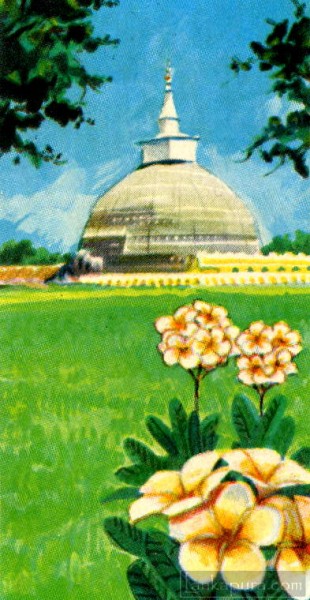
A vast variety of flowers bloom with tropical splendour in Ceylon. In the Royal Botanical Gardens at Peradeniya, on the outskirts of Kandy, a glorious colection may be seen of exotic orchids, hibiscus, bourgainvillaeas, crotons, cannas, frangipani, etc.
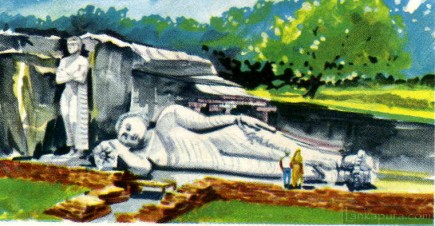
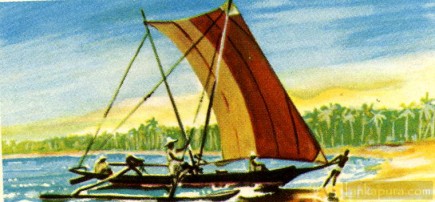

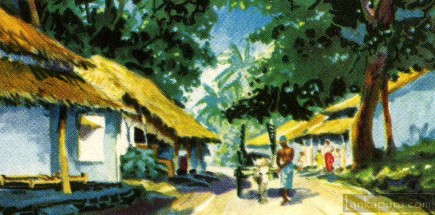
No. 7 The Village
Many villages in Ceylon are built below the retaining wall of a “tank” or artificial lake, so that they are certain of their water supply. The homes are mudwalled, with a thatched roof of straw or plaited coconut leaves, a wooden door and no glass windows. There is usually a verandah running along the front. Each house stands in its own ground and is attractively white-washed and looked after. Coconut, lime, orange, tamarind and areca palms make a picturesque background. Most villages provide a “maduwa” – a resting place for strangers – and, of course, there is a village shop. Text on Back of the card
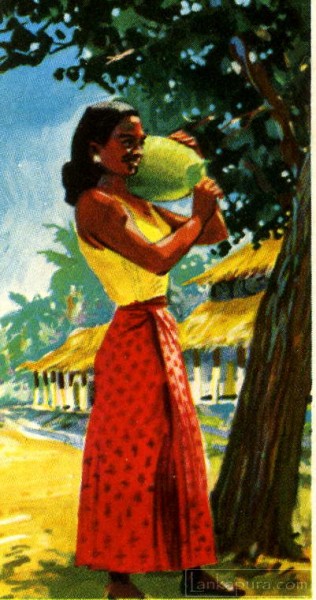
The Ceylonese Villager by nature is gentle, generous and of a happy disposition. The men, however, are inclined to be easy-going so the women have to work hard. Their day begins before dawn, when the coconuts are scraped, rice husked, millet ground and rice-milk squeezed for the day’s needs. They collect the firewood to stack in the garden. A sinhalese woman is light brown in colour, graceful and often beautiful. Her dress, or “sari”, usually consisits of 2 pieces : a bodice with short sleeves and a cloth wound round the waist, hanging to the feet. 2 or 3 inches of bare skin show between. Text on Back of the card
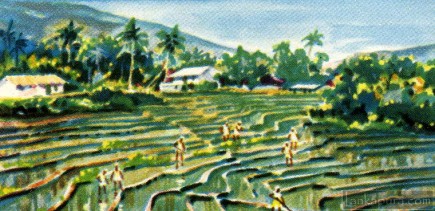

Rubber, like tea, is comparatively new to Ceylon but is now her 2nd largest industry. It started in 1876 when 1919 rubber plants from Kew were shipped to ceylon on the S.S. “Devonshire”, in charge of a gardener. The 1st exports of rubber from Ceylon were in 1900. Rubber is tapped from the trees at intervals of 2, 3 or 4 days into “cups” made from half coconut shells. Cleanliness in all the apparatus of cutting and collection is vital. The milky substance tapped from the trees is called latex. It is dried into sheets or crepe. There are about 660,000 acres under rubber in Ceylon. Text on Back of the card
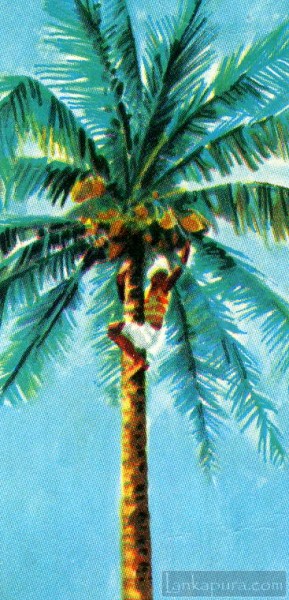
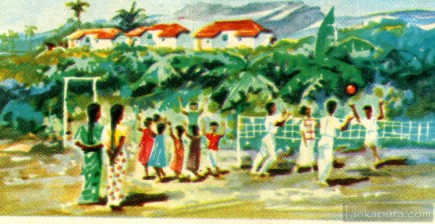
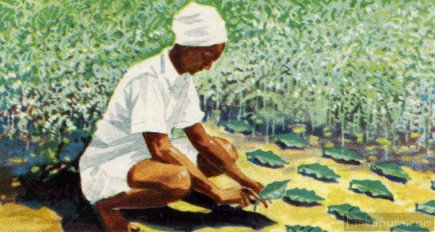
The tea plant starts life in a nursery bed on the estate. There are 2 ways of growing it-from seed, or by planting cuttings taken from selected bushes. The seeds are about the size and colour of a nutmeg. The seed bed is frequently watered and later, a rough frame-work of thatch provides shade. After 12 months or so the young tea plants are carefully dug up and replanted in open ground. The tea bush (it is really a pruned-down tree) is wonderfully hardy. It can be plucked when it is from 3 to 5 years old, and may go on yielding good leaf for 50 years and more. Text on Back of the card
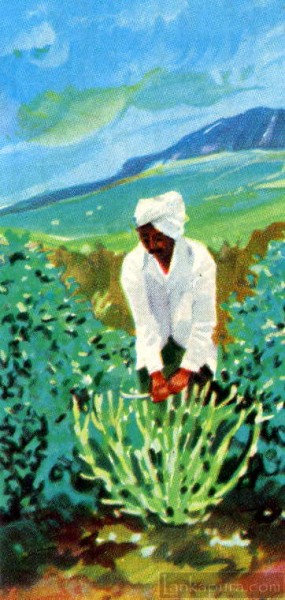
Left to themselves, tea bushes will grow into trees 30 ft. high. To keep them a suitable size and shape for the women to pluck the leaves, they are pruned at intervals of 1 to 3 years all through their lives. This encourages side growth and produces a flat-topped bush, 3 to 4 feet high. Pruning also prevents the bush from “going to seed” (some, of course, are specially left to provide new seeds) and maintains it as a constant leaf-producer. Pruning is work for the men on the estate. They use a sharp, curved knife. Text on Back of the card
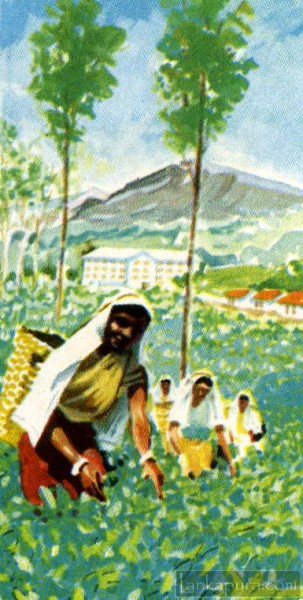
In the Ceylon estates tea plucking goes on all the year round. With quick, deft fingers, the women take the tender top leaves (2 leaves and a bud) from each shoot and throw them into baskets slung from brown-bands. Each bush gets plucked over about once in 10 days. The workers are bare-footed. They wear white cloths over the head against the strong sun. The dresses-saris they call them-look gay and colourful among the dark green bushes, but they fasten sacking across the front to keep them clean and dry while they work. Text on Back of the card
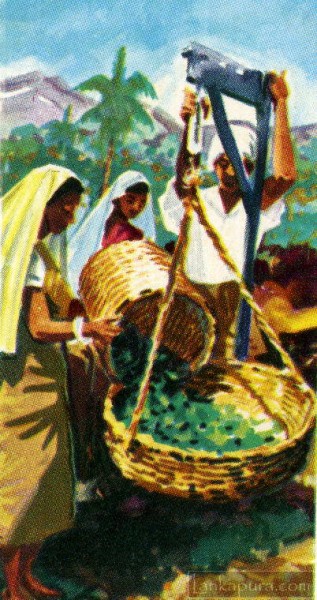
At internvals, the women pluckers on a Ceylon tea estate bring their baskets to a weighing point. The leaves are picked over for foreign matter and then weighed. Every worker gets paid extra, above her wages, for the amount of tea plucked. Experienced women can gather up to 60 lb. in a day. The scale is often a simple balance, like the one overleaf. After weighing, the tea leaf is immediately taken up to the factory for processing. Usually this is by lorry, but in mountainous estates, where the factory is often at a quite different level, the tea may be transported by aerial ropeway. Text on Back of the card
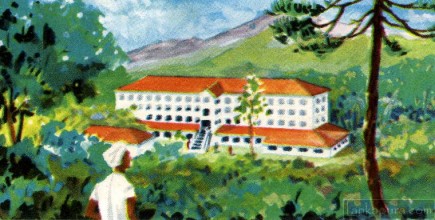
Each Ceylon tea estate has its own factory, built mainly of concrete and steel. They are big 3 or 4 storey buildings. Everything except the ground floor is used for the Withering process. The green leaves brought in from the estate are spred out on hessian or wire racks and left until most of the moisture has evaporated. They then move down to the ground floor where the processes of rolling, fermenting (or rather, oxydising) drying and sorting take place. Whereas women do the tea plucking, in Ceylon these factory processes are mostly looked after by the men. Text on Back of the card
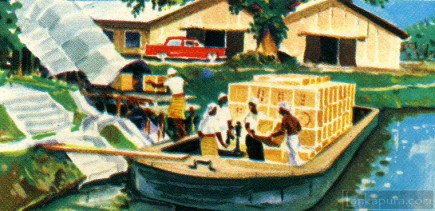



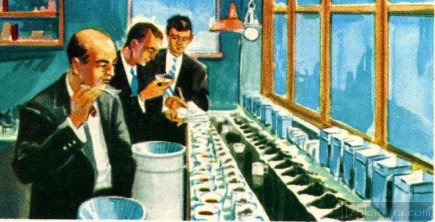
The object of blending (or mixing) tea is to ensure consistent quality and flavour all the year round. In the wet season tea loses some of its flavour so the blender has to mix in more of the better teas from other estates or seasons. After he has finished tasting, a small sample blend based on his decision is made up. This can be of 2 kinds, (a) comprising teas from a number of different Ceylon estates (known as Pure Ceylon), or (b) Ceylon teas predominating but with some from other countries mixed in (Ceylon – character blend). Text on Back of the card
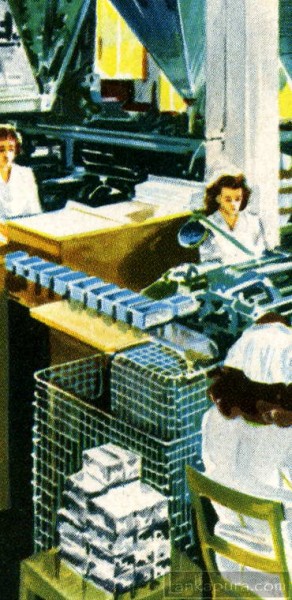
In a modern tea warehouse, the leave is not touched by hand. It is blended in bulk in a large rotating drum. The blend is then tipped into an automatic weighing and packing machine where cams and levers clutch and shape pieces of paper into tea packets. The packets pass under nozzles through which the tea pours into them, then continue on to machinery which seals and labels. Finally, off they go on a conveyor belt to be parcelled up and sent to grocers’ shops all over the country. Text on Back of the card
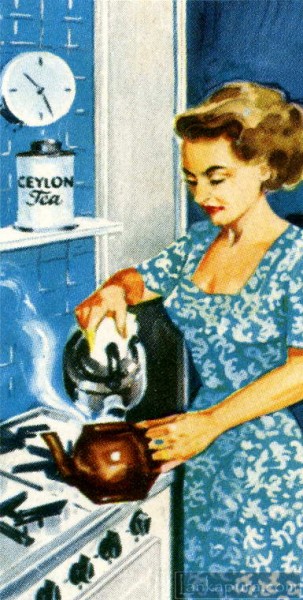
This is great.. I was looking for these tea cards for a long time.
I have these are they worth anything?
How much are they really worth I have a full set stuck in the album.
Not much!!! I got this set off Ebay for just under $10 with the booklet they originally came in, depend on the condition and if they have the booklet may cost around $9-10, if not cost less.
MY FATHER IN LAW AND HIS FATHER BEFORE HIM OWNED THE INDIAN/CEYLON TEA COMPANY IN THE WEST MIDLANDS UK FOR OVER 50 YEARS AND I HAVE AT LEAST 30 SETS OF THE ORIGINAL TEA CARD SETS IN MINT CONDITION ,AND A FEW OLD TEA PACKETS ,IF ANYONE IS INTERESTED CONTACT ME AT THE ABOVE EMAIL ADDRESS
THANKS NORMAN